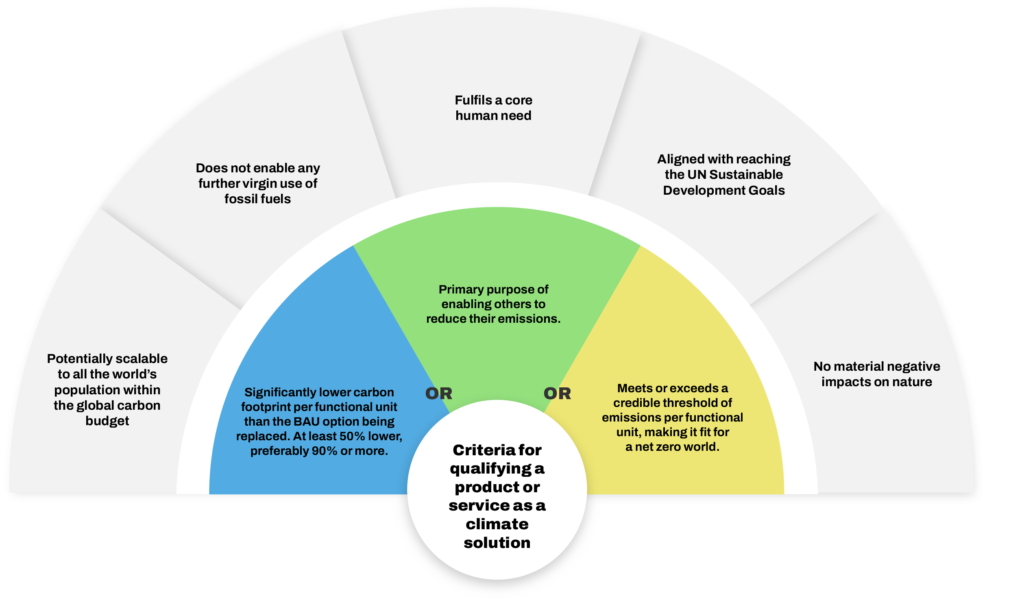Transition plans as a driver for business transformation, integrity of business climate action and climate solutions – these were the key areas of focus for the Exponential Roadmap Initiative at the UN climate change conference COP28.
In a conversation with Johan Falk on the We Don’t Have Time COP28 Climate Hub, Catherine McKenna, Chair of the UN High-Level Expert Group on the net zero commitments of non-state entities, or HLEG, made clear what a credible transition plan entails:
You can have a long term goal 2050. But you also need to have short term interim targets. You need to be reducing your emissions across all of your scopes of one to three, and your absolute emissions need to go down. The transition plan demonstrates what you need to do across your business. And you need to report transparently. You cannot say you are net zero if you’re investing or building new fossil fuel infrastructure. You cannot simply buy cheap credits rather than reducing your own emissions. And you cannot lobby against climate action, you have to lobby for climate action.
Johan Falk, CEO and Co-founder of the Exponential Roadmap Initiative, and Claire Wigg, Head of Climate Performance Practice, shared learnings gained from supporting ten member companies in developing transition plans aligned with HLEG-recommendations. Both stressed that developing a transition plan is a very broad and comprehensive exercise:
You can’t do a transition plan in one year. While it took some of the companies only two weeks to get the plan together, that was only possible because they have been working on these questions for five or six years.
A year ago, we thought a transition plan was about getting your greenhouse gas emissions down to net zero. But now the UN checklist includes questions on how you are contributing to a just transition, how you are actually going to not only reduce greenhouse gas emissions but phase out fossil fuels in your value chain, and questions around how you are going to invest in climate solutions. All of this makes the transition plan a very broad endeavour.
But it is this comprehensive nature that can – and should – result in a transition plan becoming a driver for the needed transformation, speakers agreed. Indeed, transition plans would more aptly be called transformation plans, said Claire Wigg and Johan Falk.
We’re talking about a company’s vision twenty to thirty years ahead. It’s about envisioning that future and seeing where your company is going to be in this future. What is it actually going to do in 2050?
I think most companies haven’t fully realised or even discussed whether their products really fit into a net zero world. I think it’s very likely that we will be seeing a radical transformation in which most of the products we see today will be shifted out, as well as most of the companies.
But transition plans aligned with the HLEG-recommendations also introduce a new framing to the transition in terms of phasing out fossil fuels, rather than “only” in terms of reducing emissions. Exponential Roadmap Initiative members like Icebug, who developed their HLEG-aligned transition plan with our support, share this learning, said David Ekelund, CEO of Icebug.
We already had a general direction that we would be phasing out fossil fuels as fast as possible. But when we developed our climate transition plan, this became a lot more granular. The transition planning started moving us in the direction of really mapping exactly what fossil fuels we still have in our value chain and looking at what the fastest way will be to eliminate them.
Other companies stressed the value of transition plans for tackling the inherent question of cost incurred by the transition and implications for a company’s profitability.
I think of transition plans as a map. I wouldn’t travel to a foreign land without a map. I could just wing it but it would probably take me longer to get where I wanted to be and it would cost me quite a bit more. So the transition plan is really a map for a company once it has set its targets in line with science for how to get there the fastest and cheapest way possible. – Emma Stewart, Sustainability Officer, Netflix
Developing a transition plan is a way of showing what we want to achieve and how we want to achieve it at the same time as connecting it to the business. Because it is not the sustainability team that can make this transformation happen, it is in the business, and also in the finance department because the cost of the transition also matters. -Emelie Öhlander, Climate Action Program Manager, Ericsson
With the aim of giving companies a clearer idea of what their businesses could and should transform into, Exponential Roadmap Initiative teamed up with Oxford Net Zero to launch a discussion paper for defining climate solutions and climate solutions companies. Johan Falk and Kaya Axelsson of Oxford Net Zero explained:
We need to scale up climate solutions to shift out the fossil economy. We will not succeed with phasing out fossil fuels in time if we don’t exponentially scale up the solutions. Existing companies need to transform their portfolios and new innovative companies can scale up the next generation solutions.
We haven’t incentivized companies to create climate solutions, we talk to them about reducing emissions within their inventories. While this is critical, companies are also looking to standards and policy to set their strategic direction and the climate movement has not incentivized them to use the greatest lever they have at their disposal to develop climate solutions to help us get to net zero.
Massamba Thioye, Project Executive for the Global Innovation Hub of the UN Framework Convention on Climate Change (UNFCCC) agreed and expanded on what a climate solution had to deliver.
Pure decarbonization is not mindful. What we want to have is well-being for the many people in a healthy manner. So we have to have a demand-driven approach where we start from core human needs such as shelter, access or clothing and then find solutions corresponding to this particular need. What’s more, a solution is only a true solution when it is ready for upscale deployment.
Indeed the Exponential Roadmap Initiative-Oxford Net Zero authored criteria for products and services to be defined as climate solutions require that the product is potentially scalable to all the world’s population with the global carbon budget. This is one of the so-called safeguard requirements.

The three main criteria, one of which a product or service would have to fulfil to be qualify as a climate solution, relate to emissions reductions compared to business-as-usual solutions, explained Kaya Axelsson
Climate science is at the core of what a climate solution needs to be. So the first thing we have to do is think about the emissions reductions per unit being in line with the Carbon Law, which is a 50% reduction at a minimum by 2030. Another way to define a climate solution is to say the primary use of this product is to help reduce emissions in society, it is replacing high-carbon products. The third way to think about a climate solution is to meet a threshold of emissions low enough to be in line with global net zero pathways, for instance the net zero pathway modelled by the International Energy Agency (IEA).
Fredrika Klarén of Polestar said her company worked in an industry that actually already had a scalable solution: electric vehicles. However the industry lagged behind in scaling this solution globally, she said. But:
We know that electrification is just the beginning of something that will benefit our industry. When we turn tailpipe emissions to production-related emissions, this will inspire amazing material developments and innovation and will redefine how we produce and use cars.
Another climate solution would be green steel such as the one that H2 Green Steel is set to produce, reducing carbon dioxide emissions in scopes 1 and 2 by 95% compared to the business-as-usual product. Chief Financial Officer Otto Gernandt said the necessary technologies were already available.
There is this idea that there is this huge technological leap and innovation required to produce essentially near zero steel, and what we found is that that is not the case. Every single component, starting with large scale hydrogen production is actually available. And that is a game changer from a financing standpoint, because it means that the solution can be financed.
Fredrika Klarén of Polestar said her company worked in an industry that actually already had a scalable solution: electric vehicles. However the industry lagged behind in scaling this solution globally, she said. But:
We know that electrification is just the beginning of something that will benefit our industry. When we turn tailpipe emissions to production-related emissions, this will inspire amazing material developments and innovation and will redefine how we produce and use cars.
Another climate solution would be green steel such as the one that H2 Green Steel is set to produce, reducing carbon dioxide emissions in scopes 1 and 2 by 95% compared to the business-as-usual product. Chief Financial Officer Otto Gernandt said the necessary technologies were already available.
There is this idea that there is this huge technological leap and innovation required to produce essentially near zero steel, and what we found is that that is not the case. Every single component, starting with large scale hydrogen production is actually available. And that is a game changer from a financing standpoint, because it means that the solution can be financed.





